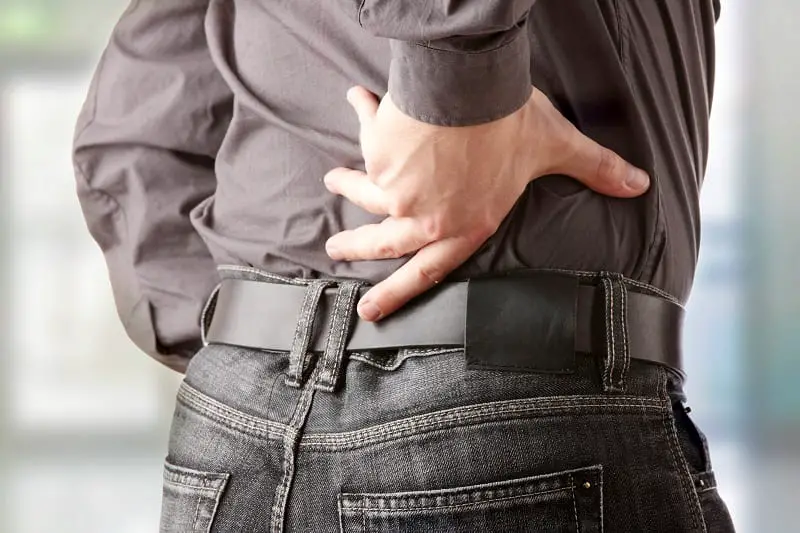If you’ve ever slept in an awkward position or lifted something the wrong way, then you are familiar with that roaring pain in the lower back.
Around two-thirds of all Americans will experience significant lower back pain at least once during their lives. The Australian Bureau of Statistics meanwhile, estimates that about four million Australians have back problems. That’s about 1 in 4 adults.
In the US, estimates of the cost of medical care for those disabled by severe back pain range from thirty to seventy billion dollars annually.
The problem is ubiquitous, and so is the mythmaking. With so much advice available these days on treating low back pain, it can be hard to distinguish fact from myth. We hope to settle a few of the more popular misconceptions about the subject for you.

Myths vs Facts
Myth: “You shouldn’t engage in any physical activity if you have low back pain. Bed rest is the best form of treatment.”
This is simply untrue. Instead of bed rest, experts say you should stay active. Continue your daily activities, and stay at work – or return as soon as possible.
Myth: “If you experience low back pain once, you’ll have it for life.”
This myth has seemingly been around forever! The truth is, however, people who experience low back pain for the first time recover quickly – usually within three to six weeks.
They can also prevent it from happening again by following simple back care procedures.
Myth: “You can only get low back pain from lifting heavy objects incorrectly.”
You can experience low back pain for a number of reasons. The various muscles, tendons, bones, joints, and ligaments of the lower back contain sensory nerves that can transmit messages of pain up to the brain. Any injury among these can cause pain.
This is also true of organs within the abdomen and the pelvis when they become inflamed or diseased. You may feel pain because of spinal injuries or malformation, as well.
Myth: “You need scans and x-rays to diagnose the cause of your lower back pain. Treatment usually requires surgery.”
You do not need scans or x-rays if you have experienced low back pain for less than six weeks. In most cases, these tests don’t help to diagnose the cause.

Scans and x-rays are only required in specific circumstances, such as spinal fracture, metastasis, or an infection.
Myth: “If you experience low back pain, you should see your GP immediately.”
Your body will often heal low back pain on its own – with some self-care. In most cases, you can simply use a heat pack.
However, if self-care treatments don’t help, there is evidence that physiotherapy, massage, and spinal manipulation can provide small to moderate improvement.
Myth: “Paracetamol can help manage your low back pain.”
There is little evidence to suggest that paracetamol is effective against low back pain. You should always aim for methods of self-care first. Try getting a massage or applying heat to the area before taking pain relief.
If you experience chronic back pain, see a physiotherapist or health professional. If physiotherapy doesn’t help, consult your GP about pain management.
Chronic pain is when pain is recurring over a long period of time. It is the opposite of acute pain which is short term.

How to Prevent Low Back Pain
James Weinstein, the head of orthopedic surgery at Dartmouth, advocates a radical improvement in the way doctors approach treatment.
Weinstein suggests doctors should allow patients unbiased information on what is known and not known about back pain. They should also inform patients of the various ways of treating the condition.
Instead of informed consent, Weinstein says patients should be able to make an “informed choice.” This involves a comprehensive understanding of all the options and their possible risks and benefits.
But then there are things you can do to prevent low back pain entirely. For instance, you should use the correct technique when lifting or carrying things.
Don’t sit or stand in the same position for long periods. Ideally, get and move at least once every 20 minutes. Sitting in a seat can place a lot of stress on your skeletal system and also restricts blood flow.
Good posture also helps, as do stretching and exercising to strengthen your muscles.
As difficult as it sounds, if you have any inflammation in your lower back, vigorous exercise appears to offer distinct benefits over the long term despite the short-term discomfort. Cycling and swimming are two options that do not place any undue stress on your back.
All exercise will help to strengthen and can even enhance metabolic activities such as calcium uptake. There is a great program called 10,000 steps which is well worthwhile considering.
If you have been experiencing low back pain for over six weeks, and self-management hasn’t worked, see your health professional or GP.
Do you suffer from chronic low back pain?






